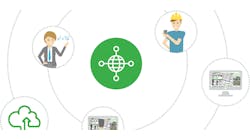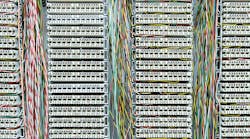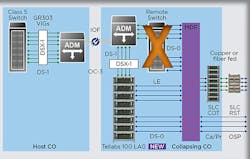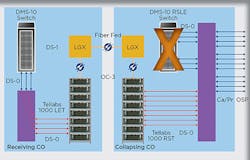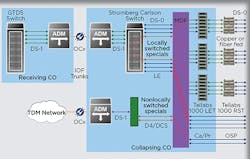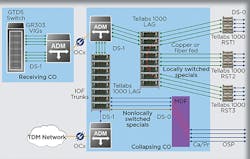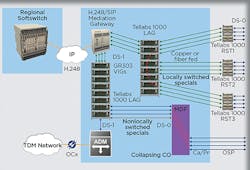Latest from C&E/NetDev Ops/GIS/Open-Source Networks
Solving Challenges of Class-5 Switch Replacement —
Service Providers are struggling with Class-5 switch migration challenges as they transition their networks to an all-IP Ethernet-centric infrastructure. Class-5 switches have reliably delivered POTS, Special Services, and Business Services, for many decades, but now the operation of these legacy network elements presents some significant challenges.
Lack of Support: No new parts are available because the systems are Manufacturer Discontinued, and most of the original manufacturers are out of business or are no longer supporting the equipment.
Lack of Expertise: As personnel retire, service providers are faced with significant costs to retain and/or develop technical support capabilities without the manufacturer’s support.
Greater Liability: As systems near end of life, component and system failure rates are dramatically increasing.
Increased Operational Expense: A drastic increase of wireless customers generally creates a drastic decrease of wireline customers. Additionally, relative to newer softswitch solutions, the Class-5 switches use more power, HVAC, and monopolize precious real estate.
Migrating to a packet-based regional softswitch addresses most of these challenges but fails to provide a complete solution, as softswitches don’t support all of the special services and business services that the Class-5 switch provides. Many of these services represent meaningful revenue streams, and some are even mandated by regulation. This means that service providers cannot simply remove the Class-5 switches from their network. A small number of Class-5 switches need to be retained in order to offer Class-5-based services until alternative solutions are implemented.
Next Generation Digital Loop Carrier systems (NGDLC) are specifically designed to cost-effectively distribute 100% of the Class-5 services over TDM or IP/Ethernet networks. This capability allows for the rehoming of services to a reduced number of Class-5 switches so that most can be decommissioned. These same NGDLCs can also deliver Digital Subscriber Line (DSL) and Ethernet services, allowing for continuing network and service evolution long after the last Class-5 switch is finally retired. This gives service providers the chance to gracefully start rehoming and removing Class-5 switches today without giving up services and revenue. Moving forward with softswitch migration has the potential to reduce service providers’ operational expenses, improve service reliability, and permanently improve their cost structures.
Flexibility Is the Key
The NGDLC are extremely flexible systems that can provide all the features and services necessary for the collapse and replacement of Class-5 Switches. A true NGDLC needs to support the following 4 services, transport, and management options:
Option 1. Services including POTS, DSL, Specials, Hi-Caps, and DS-3.
Option 2. Total support of narrowband legacy services, including locally switched services and locally switched specials, as well as non-locally switched services and non-switched services.
Option 3. Transport such as high-capacity T1, OC-3c, OC-12c, 1G and 10G Ethernet.
Option 4. Element Management System (EMS) and an optional Command Line Interface (CLI).
Service providers can deploy the NGDLC as a Central Office (CO)-based Line Equipment Terminal (LET) in the receiving CO, and as a CO-based Remote Service Terminal (RST) in the collapsing CO. This scenario resembles a typical NGDLC deployments, except for the fact that the RST is in the CO rather than in the Outside Plant (OSP).
Service providers also can deploy the NGDLC as a Line Aggregation Gateway (LAG), placing the LET and RST function in the same bay. Figure 1 shows that the LAG is located in the collapsing CO, and will be transported to the host CO via Add-Drop Multiplexers (ADM) and integrated interfaces (either GR-008 or GR-303).
Figures 1 and 2 illustrate the collapse of a remote switch into a Class-5 switch, with the NGDLC taking over the function of the collapsed switch. The Numbering Plan Area (NPA) NNX (Exchange or Central Office) code, which is derived from the host office, remains unchanged. All emergency stand-alone features remain within the
host switch.
Figure 1. LAG is located in the collapsing CO and will be transported to the host CO.
Figure 2. Telcordia’s GR-057 is used if there are no digital switch interfaces available at the receiving Class-5.
The key to this entire solution is that the NGDLC should support Universal (GR-057) and integrated GR-008 and GR-303 switch interfaces.
• Universal (GR-057) — Telcordia’s GR-057 is used if there are no digital switch interfaces available at the receiving Class-5 shown in Figure 2. This application extends the Class-5 switch’s analog line unit termination to the outside plant, thereby eliminating direct copper pairs and moving closer to the customer’s premises.
The Class-5 switch replacement application calls for the deployment of a NGDLC LET in the receiving CO and the NGDLC RST in the collapsing CO. If the objective is to eliminate the collapsing building, the service provider can deploy the RST in a Controlled Environmental Vault (CEV), hut, or cabinet, separate from the CO building.
• Integrated (GR-008) — Telcordia’s GR-008 technical specification defines the overall system functions and performance levels required when integrating a DLC system into a Class-5 switch. The GR-008 compliant integrated access interface allows the NGDLC system to consolidate DS0s into T1 spans coming from a local digital switch.
GR-008 supports POTS, Pay/Coin, and universal voice grade (UVG) circuits. Mode1 GR-008 supports up to 96 DS0s into 4 T1s. Mode2 GR-008 supports up to 96 DS0s into 2 T1s.
• Integrated (GR-303) — Telcordia’s GR-303 technical specification defines the overall system functions and performance levels required when integrating a DLC system into a Class-5 switch. The GR-303 compliant integrated access interface allows the NGDLC system to concentrate up to 2048 DS0s into 2 to 28 T1 spans coming from a local digital switch.
Switch Topologies
On occasion, service providers may need to collapse a stand-alone Class-5 switch into another stand-alone Class-5 switch or a host softswitch. In these situations, service providers must decide whether to:
• Use Local Number Portability (LNP) until full cutover of the collapsed switch, which could require "add" and "disconnect" service orders for each working line in each switch.
• Rehome the NPA NNX code to the receiving switch prior to cutover, which could require additional trunking back to the collapsed switch until after the cutover.
• Use a flash-cut or a roll-cut re-provision receiving office translations or develop a Class-5 switch cut script.
Figure 3 shows a typical CO prior to a Class-5 to Class-5 switch replacement. Customers in the collapsing CO receive their dial tone and services from that Class-5 switch; the Inter-Office Facilities (IOF) trunks between the COs route their calls to other end offices. The local Class-5 switch handles call processing within this CO serving area.
Figure 3. Typical CO prior to a Class-5 to Class-5 switch replacement.
Figure 4 illustrates the result of collapsing a Class-5 switch into another Class-5 switch. The new receiving switch now processes all calls, and local copper pairs and cables as well as additional DLCs are consolidated in the NGDLC LAG bays.
Figure 4. Result of collapsing a Class-5 switch into another Class-5 switch.
Figure 5 demonstrates the end result of collapsing a Class-5 switch into a softswitch. This collapse scenario requires the addition of a softswitch with a SIP Media gateway. The softswitch functions as an IP gateway, converting the TDM-based GR-303/GR-008 DS1 links from the NGDLC and transporting them to the softswitch.
Figure 5. Result of collapsing a Class-5 switch into a softswitch.
A Graceful Migration Path
By leveraging existing NGDLC systems, like the Tellabs™ 1000 Multi-service Access Platform (MSAP), to collapse and replace Class-5 Switches, Service Providers can solve many challenges of Class-5 Switch replacement, and enjoy a more graceful path forward to the ultimate goal of an all-IP Ethernet-centric infrastructure. This represents the best exit strategy to eliminate 40+ years-old equipment for all the reasons stated above, without sacrificing today’s revenue generating services.
Also authored by:
Tod Brinkerhoff is Director Sales Engineering for Tellabs. He has more than 30 years of experience in DWDM and PON deployments across Tier 1 and Tier 2 customers. He also helped customers with network modernization projects including replacing Class-5 switches, migration to softswitches, and removing legacy TDM equipment, in preparation for an IP-centric network. For more information, please email [email protected] or visit www.tellabs.com. Follow Tellabs on Twitter: @Tellabs.


